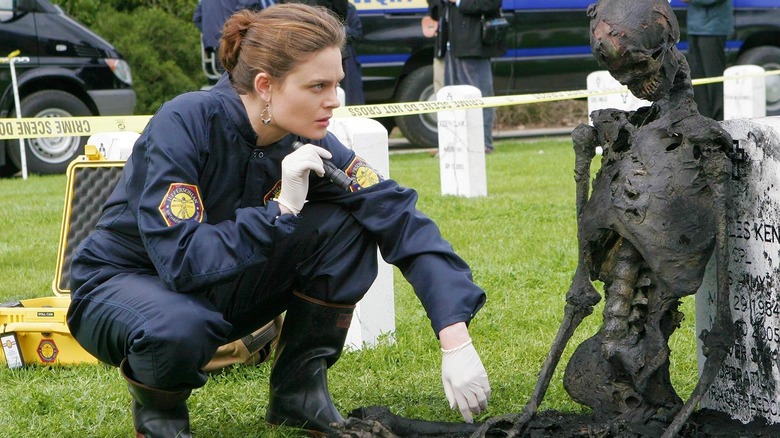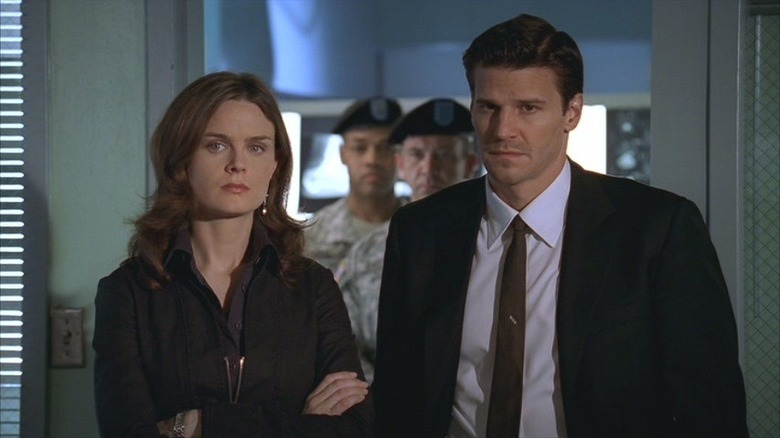Bones Created A Fictional War Scandal In Season 1 That Became Real
We may receive a commission on purchases made from links.
Premiering on September 13, 2005, and ending just short of 12 years later on March 28, 2017, "Bones" straddled the line between the post-9/11 media of the 2000s and Obama-era pop culture. You can see that in the show's politics, which, like a lot of network TV, skewed centrist for much of its run.
This is also reflected in the series' characters. David Boreanaz's FBI Agent Seeley Booth is a military man, but he doesn't that responsibility lightly. His beliefs put him at loggerheads with T.J. Thyne's sarcastic entomologist Jack Hodgins, who started out as a caricature of far-left types, spouting wild conspiracy theories fueled by his distrust of the government. Emily Deschanel's anthropologist Temperance "Bones" Brennan, ever the rationalist, was the buffer between them and was only ever interested in the facts of their murder investigations, not assumptions or gut feelings.
Season 1, episode 21, "The Soldier on the Grave," tests Booth's idealism when he and Bones find a charred dead body atop the grave of Charlie Kent, a prospective NBA star who died while protecting his unit in Iraq. It soon comes to light that the corpse is that of Devon Marshall, a former member of Kent's unit. Booth, whose wartime trauma is triggered by the case, projects his own feelings onto Marshall, reasoning that he was experiencing survivor's guilt and died by suicide. However, further examination of his body suggests he was murdered.
As always, it takes Booth and Bones' combined efforts to uncover the truth. Marshall, as they come to discover, was murdered as part of a larger attempt to cover up an incident in which a squad of U.S. military men killed a group of innocent Iraqi civilians. If that plotline sounds familiar, it's because it bears an uncanny resemblance to a real-world U.S. military scandal.
Bones and the Haditha massacre
On November 19, 2005, U.S. Marines based in Haditha killed 24 unarmed civilians after an improvised explosive device (IED) was set off by a convoy entering the Iraqi town, resulting in the death of a Lance Corporal and severe injuries to others in the vehicle. However, the incident didn't receive widespread public attention until Time Magazine published an article titled "On Scene: Picking up the Pieces In Haditha" on May 29, 2006. This led to further investigation by the U.S. military, revealing that a group of officers had covered up the truth of what happened during an initial probe of the incident.
"The Soldier on the Grave" aired on May 10, 2006, well before the Haditha cover-up had become common knowledge. When interviewed for Paul Ruditis' book "Bones: The Official Companion," the episode's writer, Stephen Nathan, admitted he was shocked when the news broke just a few weeks later. "I wrote that episode and it was fiction," Nathan explained. "A month later, the whole Haditha scandal came out. The episode was not based on that at all. We had no knowledge of it."
This wasn't the only time "Bones" seemed to predict a real-life tragedy in what was actually a case of art unknowingly imitating life, although the parallels between the show and reality stop there. Where "The Soldier on the Grave" ends on a note implying justice will be served thanks to Bones and Booth's actions (despite the toll it takes on Booth's emotional well-being), none of the Marines responsible for the Haditha massacre were ultimately jailed for their involvement.
But that was very much in keeping with the series' centrist leanings. Like most procedurals, "Bones" is a fantasy about the justice system working the way it should and not the way it does.

